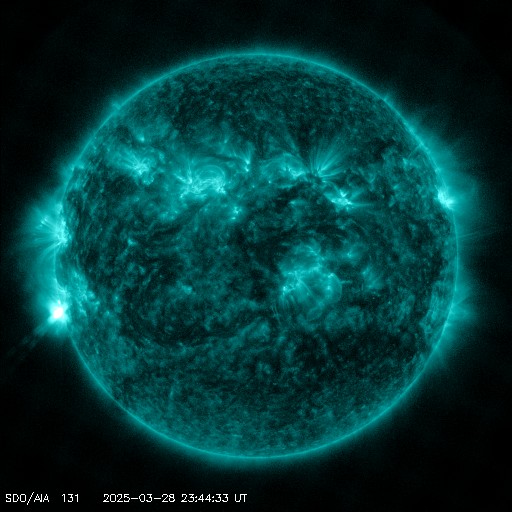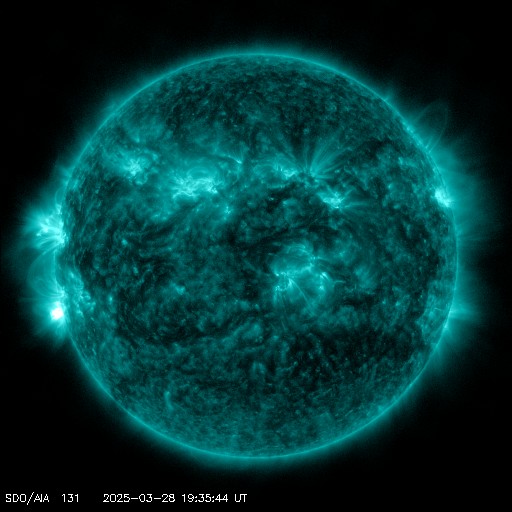Viewing archive of Wednesday, 18 June 2003
Solar activity report
Any mentioned solar flare in this report has a scaling factor applied by the Space Weather Prediction Center (SWPC). Because of the SWPC scaling factor, solar flares are reported as 42% smaller than for the science quality data. The scaling factor has been removed from our archived solar flare data to reflect the true physical units.
Report of Solar-Geophysical Activity 2003 Jun 18 2200 UTCPrepared by the NOAA © SWPC and processed by SpaceWeatherLive.com
Joint USAF/NOAA Report of Solar and Geophysical Activity
SDF Number 169 Issued at 2200Z on 18 Jun 2003IA. Analysis of Solar Active Regions and Activity from 17-2100Z to 18-2100Z
Solar activity increased to high levels today. Region
386 (S07E43) produced an M6.8 x-ray flare (correlated using SXI
imagery) at 17/2255Z that had an associated Tenflare (2100 sfu),
Type IV and Type II radio sweeps (an estimated shock velocity of 1000
km/sec). This region showed growth in the magnetic structure
surrounding the dominant lead spot as a delta complex has become
evident since yesterday. The penumbral field coverage has changed
little over the period. Newly numbered Region 387 (N18E62) produced
several minor flares during the interval.
IB. Solar Activity Forecast
Solar activity is expected to be at
moderate to high levels. Region 386 has the potential to produce an
isolated major flare.
IIA. Geophysical Activity Summary 17-2100Z to 18-2100Z
The geomagnetic field was at predominantly minor to major storm
levels with an isolated period of severe storm conditions seen at
high latitudes between 18/0600 and 0900Z. A co-rotating integrated
region preceding a recurrent high speed coronal hole stream and is
believed to responsible for the storm conditions. The greater than
10 Mev proton flux at geosynchronous orbit reached event threshold
at 18/2050Z and due to the recent activity the exact source for this
particle event is not certain.
IIB. Geophysical Activity Forecast
The geomagnetic field is
expected to be at predominantly active to minor storm levels due to
a recurrent high speed coronal hole stream. Isolated major storm
conditions are possible on day one due to the potential for
transient activity. The greater than 10 MeV proton event should
remain above threshold level through the first day of the interval.
III. Event Probabilities 19 Jun to 21 Jun
| Class M | 60% | 60% | 60% |
| Class X | 20% | 20% | 20% |
| Proton | 99% | 50% | 25% |
| PCAF | in progress | ||
IV. Penticton 10.7 cm Flux
Observed 18 Jun 120 Predicted 19 Jun-21 Jun 120/120/120 90 Day Mean 18 Jun 125
V. Geomagnetic A Indices
Observed Afr/Ap 17 Jun 030/050 Estimated Afr/Ap 18 Jun 035/050 Predicted Afr/Ap 19 Jun-21 Jun 025/035-020/025-020/025
VI. Geomagnetic Activity Probabilities 19 Jun to 21 Jun
| A. Middle Latitudes | |||
|---|---|---|---|
| Active | 40% | 50% | 50% |
| Minor storm | 30% | 20% | 20% |
| Major-severe storm | 15% | 05% | 05% |
| B. High Latitudes | |||
|---|---|---|---|
| Active | 40% | 50% | 50% |
| Minor storm | 40% | 30% | 30% |
| Major-severe storm | 20% | 10% | 10% |
All times in UTC
Current data suggests there is a slight possibility for aurora to appear at the following high latitude regions in the near future
Gillam, MB, Yellowknife, NTLatest news
Latest forum messages
AR4046 100Aurora photography hints for those of us with smartphones 48Large Coronal Hole 25 178Incoming & Unnumbered Active Regions 1655LASCO Data Not Updating 5
More topicsSupport SpaceWeatherLive.com!
A lot of people come to SpaceWeatherLive to follow the Sun's activity or if there is aurora to be seen, but with more traffic comes higher server costs. Consider a donation if you enjoy SpaceWeatherLive so we can keep the website online!

Latest alerts
00:00 UTC - Solar flare
Moderate M1.79 flare
Friday, 28 March 2025
23:36 UTC - Radio Blackout
Minor R1 radio blackout in progress (≥M1 - current: M1.04)
21:24 UTC - Hemispheric Power Index
The OVATION model predicts the Hemispheric Power Index to reach 51GW at 21:59 UTC
19:45 UTC - Solar flare
Moderate M1.16 flare
19:27 UTC - Radio Blackout
Minor R1 radio blackout in progress (≥M1 - current: M1.1)
Space weather facts
| Last X-flare | 2025/03/28 | X1.1 |
| Last M-flare | 2025/03/28 | M1.7 |
| Last geomagnetic storm | 2025/03/27 | Kp5 (G1) |
| Spotless days | |
|---|---|
| Last spotless day | 2022/06/08 |
| Monthly mean Sunspot Number | |
|---|---|
| February 2025 | 154.6 +17.6 |
| March 2025 | 128.3 -26.4 |
| Last 30 days | 128.3 -23.7 |




